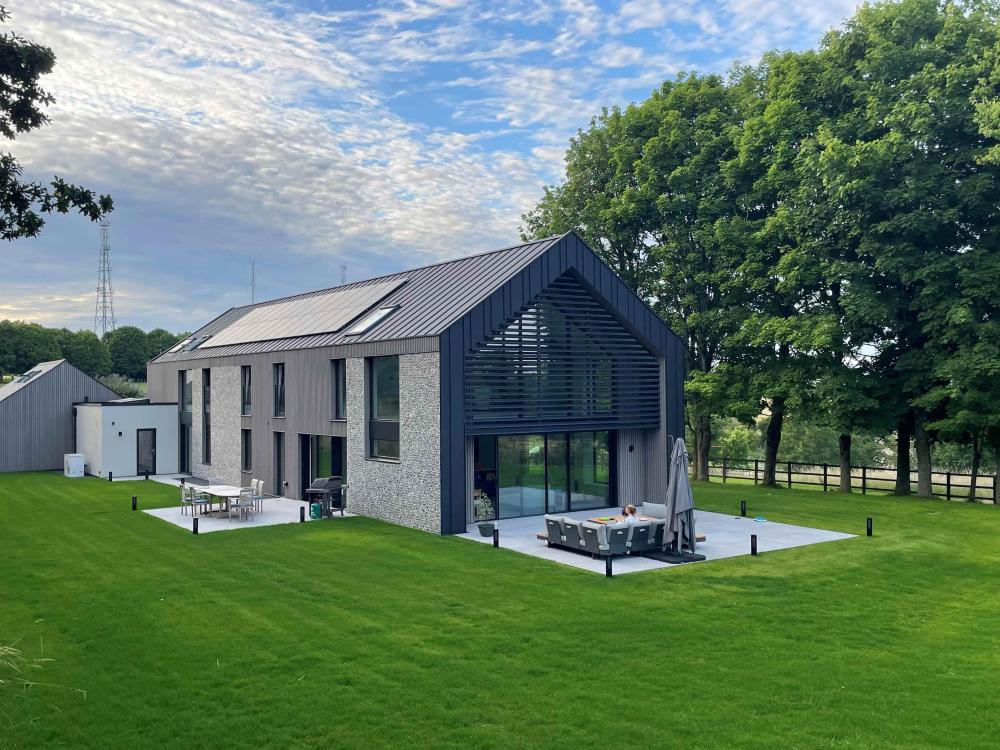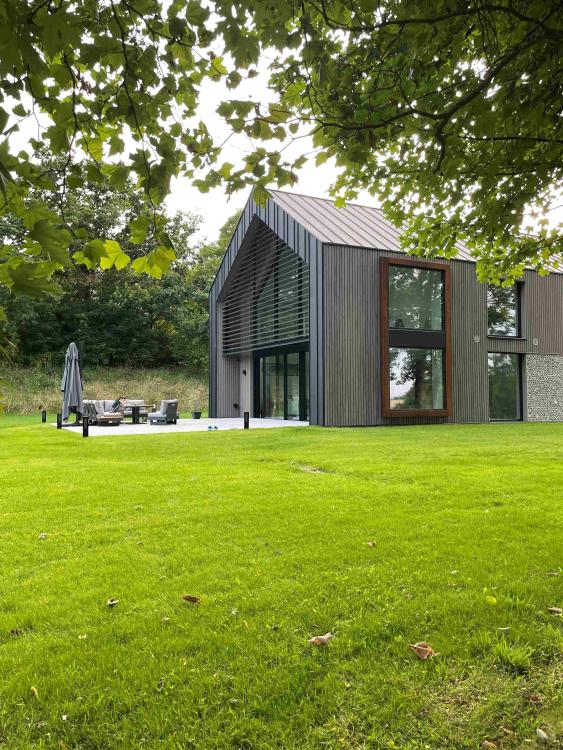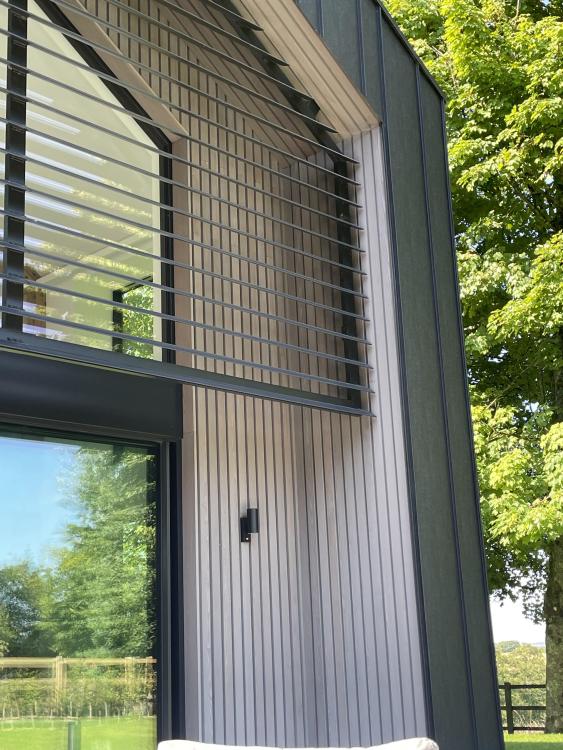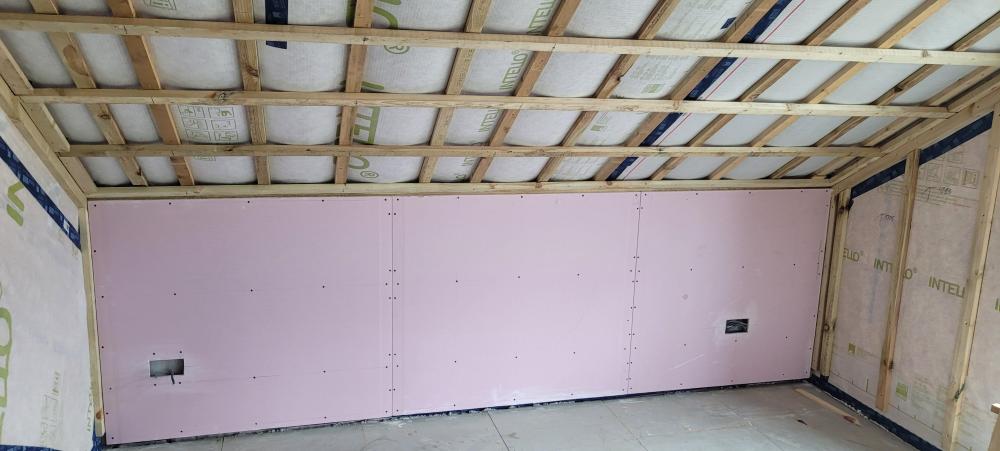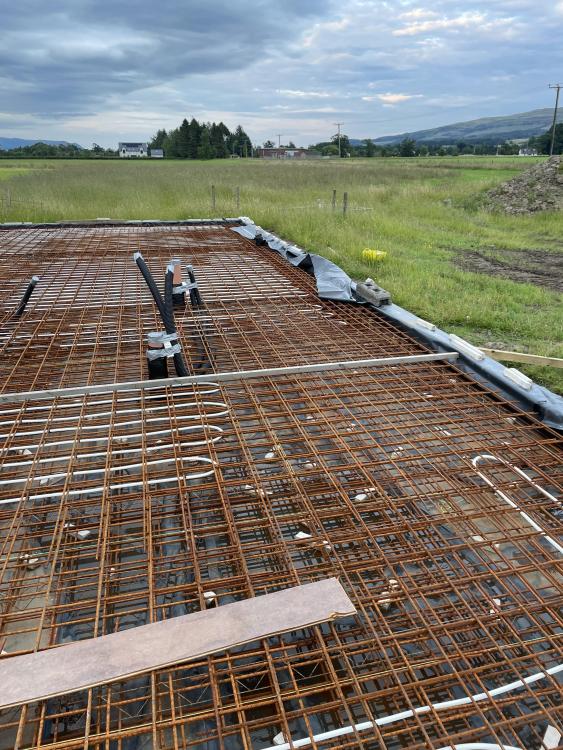Leaderboard
Popular Content
Showing content with the highest reputation on 07/19/24 in all areas
-
15 points
-
I would have the CU inside the house, then just a single incomer. Use a hockey stick tube and then easy to seal at floor level. Then take power to the garage with a single cable to a dedicated CU for the garage.2 points
-
HI - here is a snap of the cladding - its Siberian larch (which we just managed to get before stocks dried up) - from recollection its 70mm-x20mm board on board - spent ages working through style options and ended up matching a national trust property building in Ireland that had its own saw mill - so its the smallest cheapest way to go but i think also has the nicest look bar a shadow gap which is another long story !2 points
-
Well, getting a Structural Engineer to visit was thoroughly worthwhile. He came today and passed all the lintels as fine, though said that with the slightly bowed one with a slightly twisted window on the landing, if it was his house he'd replace this one while the window was out - but it was up to us because the state of the window could be down to poor fitting. All cracking is thermal cracking and nothing large enough to be of concern. The biggest win was the outer leaf of the bay window base, which a builder told us would have to be taken down and rebuilt, including digging out new foundations. For this the structural engineer reckoned that replacing one or two courses of bricks at the top (the most water damaged), and adding more wall ties as there's only 3 would be all that's needed, even with the extra weight of triple glazing.2 points
-
It's not good Engineering, it's attempting to work against physics. Vapour flow travels from a high vapour pressure to a low vapour pressure. Vapour pressure is a measure of water saturation in air, ie. absolute humidity rather than relative. Colder air outside is able to carry less moisture than warm air inside. In most circumstances, humans living inside a house put more moisture into the inside air than the climate does outside. So, generally there is a higher vapour pressure internally than externally. Vapour, as do gasses, moves in the direction from high pressure to low pressure, until equilibrium is achieved. The natural order of things is for the vapour with the higher absolute humidity to move towards that with the lower. The majority of time in our climate that is in to out. If you then try and interrupt this by not stacking your materials progressively more vapour open from in to out, you will either slow down or block altogether the vapour flow.1 point
-
Yes we did blow it in ourselves and there were not any voids when we did it for 8 months, then we had heat wave and I noticed the bulges getting worse and found the voids at the top. So we added the intermediate battens - chamfered the edges to avoid damage the membrane and then refilled the voids. No problems since.1 point
-
External clear pipe with diagonal lines painted behind the pipe. Shows the meniscus clearly1 point
-
It's not (directly) related to MVHR, it's simpler. With all else equal, RH increase as air temp reduces. In the UK we generally want the internal temp higher than the external temp. If warm vapour gets into the a building's walls, as it moves through the wall from inside to the outside it's temperature will drop and the RH will increase. If/when the RH reaches 100% the dew point is met and it will condensate. In a timber structure, if condensation occurs within the structure and its not able to dry out, the structure will rot. Even if it doesn't rot, the insulation performance will dramatically reduce. The Vapour Check Layer is to reduce the amount of vapour getting into the structure. Additionally it's typical to also ensure that vapour permeability of construction layers increases from inside to outside to aid the water vapour natural movement out of the structure. So VCL towards the inside and progressively more vapour open materials as you move out. Don't confuse airtightness with the VCL. The air tightness layer will happily exist within the outside construction layer, as long as that layer is vapour open. It is also fine to combine the air tightness and VCL on or close to the inside layer, as a self-builder you'll ensure that cold air can not breach the insulation and contact the back of the plaster board (or air tightness layer), but volume builders aren't always so successful. While it's good to understand the physics, hopefully you plan get some professional support with your wall/roof build up.1 point
-
A piece of plastic pipe glued to a small ball and a clearance hole in the lid. You can even paint 'Full, half-full and empty' marks on it. Of course the clearance around the pipe means that ingress of 'foreign bodies' is not prevented.1 point
-
At least I do agree with one part of your recent posts.1 point
-
What did they write about that we’re currently facing? Why is the outlook bleak/why have we lost hope as a ‘race’ (species?). Not gotcha questions, just interested in your viewpoint, and looking for positives. Global population is probably as prosperous as it has ever been currently. Not something to be demoralised about it. A great achievement. The number of deaths due to extreme weather events has reduced over the past 100 years, despite rising temperatures - perhaps even because of them? Less people die from extreme heat, than cold. We can adapt to rising temperatures, as we did last time temperatures rose to the levels predicted by the IPCC. I won’t say it doesn’t worry me, but in comparison to air quality, water quality, geopolitical risk and cultural change brought about by many things, including social media, I have to say rising temperatures concerns me less. Maybe I’m being ignorant and don’t understand the risk of some tipping point event - but from what I can see the IPCC is not really committing to that sort of scenario, other than some sort of social/political unrest event, caused by water/food shortages etc. Seems to me that they’re doing a good job of risking that scenario without climate change, more due to their hare brained ideas being imposed on us.1 point
-
In the late 1970's I read MAD magazine where they had cartoon scripts, some of which were about how different things would be in the future due to a hotter climate etc. Low and behold we're facing what they wrote about. This must be a coincidence. Surely we didn't have the science then to see this coming. Surely people would have listened during the last 50 years. Surely the majority of the people ( and therefore the deciding factor about what the priorities are) would have decided to change the way we all live and not face such a future. Apparently not. I've given up on humanity and concentrate on doing my bit where I can. As the planet's climate changes swiftly now, but humans still resist adapting quickly enough the outlook is bleak. Some individual rights will have to be superseded by population rights or we will lose all hope as a race. On a positive note all this sun and rain has brought on my potatoes a treat. Good luck Marvin1 point
-
You have got the extension work done very cheaply! It looks like a 5x3m extension which should cost a minimum of £15k, so the fact that you might not get them back is to be expected! You definitely cannot keep the roof as it is. It will let water in, certainly the bottom couple of courses. Find a roofer by word of mouth, local Facebook groups etc. Hopefully you can get away with stripping off the bottom few rows of tiles, but you would see the change in gauge. You will need to buy some eaves tiles so keep things cordial with the original builder and find out the exact roof tiles you have got.1 point
-
Important points. Unfortunately that's no longer the case; they overtook us in 1998. In terms of cumulative emissions since 1750, and by 2022 the UK had contributed 4.45%, Germany 5.3%, Russia 6.73% China 14.7% and the USA 24.08% More info and animation at https://ourworldindata.org/grapher/share-of-cumulative-co2?tab=map1 point
-
1. The roof gauge has been set out incorrectly. The first row of tiles should overhang into the gutter, ideally it would be 1/3-1/2 way across, whereas this looks like its only just over the gutter. Also the roofer has used tile and a halfs for the eaves by the look of it, so it will be out of bond every 3rd tile. 2.Not the end of the world, I wouldn't go back to put it in 3&4. Should be fine. Check it is nailed and not screwed, as many "builders" who think they are carpenters use screws! Bifolds: Cut off section of lintel is generally ok, but check with the building inspector before covering over. Metal shim under the steel is the correct thing to use, better than packing it with slate. Check that it is level though!1 point
-
1 point
-
It is a timber frame with passive principles applied (sensibly!) , Aluminium roof (part slate), ASHP / UFH / Triple glazing, totalling about 6000sq ft over three stories plus garage - all done with day rate subbies and frame company - we PM'ed and did the demo, site prep, garden and about 12moths labouring plus H&S ourselves - Flint was on surecav and cladding cyberian larch More than happy to answer any questions Bob1 point
-
I only use it for lighting blocks, and this explains better than I can: It is very smart. Choose what to include in the replay and check on Presence Simulation in Loxone Config. Then at any time you want to switch it on you have the last week's actions recorded to be replayed. I include external lighting and lighting blocks from main internal rooms.1 point
-
If we all adopted “. I will when they do”. Attitude then nothing will ever get done.1 point
-
That is quite a bold statement. China does have high emissions, but they are the wields largest manufacturing nation, so we really need to account for the embodied CO2e on their exports. As they did not start industrialising until the 1970s, their accumulative CO2e is still way lower than the UKs. This is important because the gasses stay in the atmosphere for decades, and in the case if carbon dioxide, centuries. China is also the largest installer of renewable technologies. So rather that blame everyone else, take some personal responsibility and change your habits.1 point
-
Yep, that’s stress we were on about. Maybe @Gus Potterknows someone or can advise1 point
-
We used intello plus as it has strengthening strands for exactly that - but it didn't work as expected we had bulging much more than expected on the first pumping. We put additional supporting vertical battens under the horizontal battens that hold the plasterboard, at 300mm centers to keep it in check. (Main studs are 600mm. This bulging gets worse when it gets really warm as the plastic stretches and we got some slumping on the tall.columns. So I let it slump and them filled any gaps with more cellulose when I found the voids with an IR camera / strong torch- if you put a bright LED against the membrane you can see holes. Attached is a pick of a roof section the 300 centers.1 point
-
Thank you both for your replies once again 🙂 Hi Joe Sorry I meant i will be 4.1 meters away from there house. the garden wall is my responsibility it has a T on my deeds but we will not be doing foundations lower than that wall or the neighbours house (which is 4.1m away)1 point
-
Having studied climate change at the academic level for nearly twenty years, and had a serious interest in it for well over 40 years (well more reducing energy usage than climate change), I have got over the depressing, hopeless feeling now. I just try and think up ways to cope (mitigations) with climate change. One thing that I do find frustrating is the lack of understanding of the problem with the general population. The media must start taking some lead hear and stop doing the scare stories. The 'science' is not hard to understand at all, I can teach why elevated levels of atmospheric CO2e is causing higher global temperatures, in an hour. But without 'official' backup from the media, there is little point as you just end up having to counter claim bad journalism.1 point
-
Local knowledge is essential Avoid digging the road. Who owns the land off the road.? Probably Lord something, but the estate factor may be approachable. A local groundworker may know the dodges, as well as being able to lay it. It is just a cable. They have to do the 2 ends. You do 70m in one length at the right depth etc. Read the small print again. An approved contractor must do it, or is preferred?1 point
-
Yeah! Just need to find some metal tube...and cut.....or buy 'the tool for the job': https://www.showerspares.com/search/crosswater-cartridge-removal-tool-sc51/?gad_source=1&gclid=Cj0KCQjw-uK0BhC0ARIsANQtgGMYv_HizFVrDNcccRhlClDiRepyu7W9-F0FC5qt9o42sva-oDrCJGwaAvwsEALw_wcB1 point
-
Just leaving the epdm longer so water flows directly into the gutter would have been a good start.1 point
-
That’s probably spot on @David001, have you got any photos of the substructure? Get some money back money off the original installer (if you can) and then don’t invite the back, take your time to find someone who can do a professional job (what you’ve got should be ok for a few months) and get it redone properly. Sounds like a complete load of bollox but even if it was the case it would just be the front part of the trim that would need replacing which is pennies in the grand scheme of things.1 point
-
It really needs a structural engineer to do an inspection rather than a builder. Sometimes joists hangers are needed, sometimes skew nailing is acceptable. Similarly for the ledger plate connection (although the single lone fixing definitely looks a bit weedy) and padstone questions. If there's a steel presumably there are structural calculations available so it's not starting from scratch.1 point
-
Just my 2p worth. If it looks that bad from what you can see, it will be worse that's covered up. Think of the over all cost of repairing a lot more than just the trim of the epdm. Contact the guy (he's not a tradesman he's a chancer) and tell him your second opinion has confirmed the work is substandard, and that it he isn't willing to refund you the labour costs, then you'll consider legal action to recover the entirety plus costs of putting it right. You will have countless sleepless nights every time it rains hard, the wind blows strong, or there is snowfall sitting on it. No amount of cost would offset that. Get someone in to do a proper job. You'll be glad you did1 point
-
1 point
-
1 point
-
For me I would weigh up getting a bit of professional advice (say £300 - £400 + vat) against say a days builder's labour and materials that could prove a waste of time.. or make things worse. I hope the following helps a bit. Take an old building like yours 1920's. Door frames tended to be made out of 6" x 2" timber with bricks over. The bricks and timber interacted a little so developed what we today call composite action.. in those days they knew it kind of worked but could not quantify it. Window frames were more sturdy timbers and these too interacted with the surrounding walls. I see this a lot where folk are making open plan spaces and wonder why I want to introduce wind posts and other stuff. But I point out.. hey you now have PVC windows which are very flexible.. some silicon and plastic DPCs which create slip planes.. so now there is no interaction and things start to bend / protest. For me I go back to the way to when the building was constructed.. try and understand what has changed and when.. then try and work out what to do next.. in a cost effective and buildable way. To do this well you need to examine the whole building to get a feel for it and then look in detal at the windows / doors etc.1 point
-
We have just finished a self-build and as we went along I made notes of the things I had learnt during the process. What follows are those notes and I hope they will be of some use to people who are just starting out on their projects. I must of course add the caveat that all that follows is only my personal opinion. Although I now have some experience I am no expert and it is of course up to everyone building their own home to seek professional advice about their project. RED'S ADVICE FOR SELF-BUILDERS 9th September 2018 GENERAL 1. Try to work with everyone on your project via email as much as possible so that you have an audit trail of what has been said to people. If you must have a meeting, confirm everything in writing, right from the start. 2. You are about to be on the receiving end of a lot of documents, mostly in electronic form. I kept all ours and it amounted to 1,132 files (in 169 folders) consuming 2.8 Gb of data. Decide early on how and where you are going to store your documentation (electronic and paper) and stick to whatever system you are using. DESIGN 3. Make sure the house is of a specification that is appropriate to the size/type of home you are building. A big expensive house must have a high specification or else you may find its value is disproportionately affected when you come to sell it. 4. Check the local vernacular for design ideas – it can be nice to reflect local building techniques or features and you will get fewer objections from the local community and council. Imposing your personal taste on an area is unlikely to make your life easier. 5. Keep basement walls as simple as possible – they don’t have to exactly reflect the above-ground level walls. Angles and corners increase cost, sometimes unnecessarily. 6. From the design phase onwards, ask that ALL drawings of plans and elevations include a metre scale so that when measuring things you can see how big they are. Sounds obvious but they were not included on ours. 7. Drainage issues can present huge problems in the future if you’re not careful. Look at your plans and see how close your sinks, baths, showers and toilets are going to be away from the soil and vent pipes (probably in the perimeter walls). The longer the distance the more difficult things get and the more likely you are to be plagued by blocked drains in the future. Additionally, be aware that the higher the volume of water, the steeper the gradient of the pipe and the larger its diameter should be. Otherwise you can end up with gurgling sounds, low water exit flow and blockages. This is all in BS5572 and is not that difficult to understand. In short, if you possibly can, keep plugs close to soil and vent pipes and make sure you can access/rod the pipework when it gets blocked! 8. Think twice before selecting fancy plug fittings for sinks. Ask yourself “How is anyone going to be able to fix this when it’s installed and covered in limescale/dirt/etc?" 9. With all fittings/equipment that may need servicing at some point in the future, will you know who the manufacturer was and will you be able to get spares? 10. Decide early on what type of cupboards you are going to have – don’t leave it until later on in the build. Ikea do a great range of cupboard carcases. If you want to go for these cheaper, pre-made type then the rooms can be sized to accommodate the standard sizes these units come in. 11. Be prepared for the fact that contractors involved in the building process rarely have any visibility of or interest in innovation. You may hear them say that that have been in the business for x years and have a wealth of experience but the problem is that what they actually have is a lot of experience doing the same thing over and over again – they tend not to be interested in new products, techniques or materials. Although it’s boring, the more standard your design is the easier your build will be. 12. In your design pay attention to the direction doors open and the positioning of light switches. 13. Ask how your architect/designer/builder wants you to provide information on the locations for items in rooms, e.g. sockets, switches, lights, etc. What symbol scheme should you use? 14. Check that the sanitary ware works together properly. Our toilet flush buttons are (annoyingly) hidden by the seat when it’s up. 15. A good rule for exterior tile and brick colours is ‘dark at the top, lighter at the bottom’. 16. Don’t use small stones on the driveway – it gets picked up on shoes and taken into the house. 17. Wood-effect porcelain floor tiles are very good – very hard-wearing and they look realistic. 18. If you're running water supply pipes some distance from the road, pay a bit extra and have the largest diameter fitted (63mm outside diameter?). Whilst static pressure may not be affected by narrow pipes when the water is not flowing, the pressure may drop substantially once flow starts. Trying to fix poor water pressure is expensive - fitting a large diameter pipe is cheap. Note that the connection to the main at the road will be a 'standard' size and will certainly be smaller than 63mm! PLANNING PERMISSION 19. The planning process is not nearly as hard as it sounds. Consider doing it yourself – don’t pay someone to do it if you feel you can. 20. If there are any trees that need to be cut down for your development, do it before you apply for planning permission but of course ensure that there are no Tree Preservation Orders (TPOs) or other restrictions in place. 21. Check that there are no restrictive covenants covering your property. You can check this to some degree of certainty by ordering the electronics deeds to your property (you can download them from the web for a few pounds). You can get restrictive covenant protection insurance just in case someone surprises you! It is reasonably cheap. All covenants are for the benefit of someone – and it is these people who can make a claim against you if you break the terms of the covenant. 22. Try to work with your local planning department rather than against them. Their aim is to build as many houses as possible (to meet government targets). Believe it or not they are on your side but they have the local residents at their throats trying to stop any building in their area. Give them reasons to allow your development. 23. Make your design a little bigger than you want and negotiate down. 24. During the planning process, all the documents that you submit to the council are likely to be published on their website. This in turn will be indexed by Google and other search engines. If you have submitted electronic copies this will mean that details such as your name and address will be instantly retrievable by anyone in the world. Therefore, if you want to retain some degree of privacy, always try to submit paper, hand-written copies of all documentation. 25. Keep records of everything that appears on the Council website – particularly the letters written by local residents. They will probably get deleted after a few months but having them in your possession can be extremely useful. 26. Planning departments express opinions on planning decisions to be made by councillors based on local and national policy. Highways departments do not have opinions – they have rules which allow them to provide planners with information about the way that a scheme will or will not meet Highways requirements. However, note that planners are allowed to ignore this guidance if they wish. 27. Back up everything you agree in person or on the phone with the planners with an email. PROJECT PRICE 28. Your project is going to cost you a lot more than you thought. There are several reasons for this: - Your contractors will not be motivated to watch your costs as closely as their own and so will find that things are more expensive than they thought they would be; - Contractors are not necessarily perfect at planning – they may be genuinely unaware of costs that emerge during the build and this ends up costing you money; - Prices tend to rise rather than fall; - You can’t remember everything and there will be things that you decide you want that you hadn’t budgeted for. 29. We found that ‘PC Sums’ (see Explanatory Note below), i.e. the non-fixed sums that amount to whatever the builder has to pay, were nearly always over the estimate, between 20-60% (and that’s without any extravagance!). If you decide that you want a more expensive option than a ‘normal’ item which would represent ‘par’ for the project then it is fair that you should pay more. However, on a fixed-price job, make sure you agree that PC sums are not allowed to escalate when you only want the ‘standard’ level of item. My recommendation here is: - Try to get rid of as many PC sums as possible. - Obtain some sort of agreement that the PC sums will remain within control. It is very important that they have some focus on giving you a REALISTIC idea of what your costs are likely to be rather than just minimum figures. Note that it not in their interests: -- to price up to a reasonable amount for PC sums (because it reduces the chance of getting the contract) -- to expend work to reduce over-spends on PC sums. - Set default prices for items of the most basic specification which could be installed for the PC sum if you have run out of money. For example, ask for a price for a specific fireplace that you would be happy with if you were running out of money. - Make a rule with your builder that whenever an item is quoted for against a ‘Prime Cost’ (or PC) sum item, that the PC sum is also given, otherwise you end up being asked “Is x thousand pounds ok to pay for item y?” when you don’t know how much the PC cost was for that item. 30. For an expensive product which is relatively easy to specify, get lots of quotes. This is more difficult with a custom-designed object like a staircase – you are really buying into the company that will design and make it for you and this may be a long process. 31. Ask your builder if they intend to charge an additional sum for some amount they have to pay to the builders’ association or something similar. This can occur if you ask them for a more expensive item, e.g. a better roof, and the cost of installing it is higher than you expect because the builder has to pay a premium to an association based on costs. 32. A significant cost will be the various charges and levies that the council will make against your project. Planning permission will be granted subject to the council receiving this money. 33. Check to make sure that ALL the costs are included in the price. We had to pay thousands of pounds extra for things like fitting a new gas connection, air circulation system and digging up the road for the water main. Make sure there are no (predictable) hidden costs. 34. Ask what the contractors will add on for anything that they buy (often 10%). You might be able to save money by ordering some things yourself. ARCHITECTS 35. Undoubtedly architects can assist a self-builder but we didn’t use one. There were several reasons for this: - We knew pretty much exactly what design of house we wanted - Architects are generally VERY expensive - They often have their own vision of the house which they try to impose on the client. A frequent complaint from clients is that they feel that they have had to persuade their architect to give them what they want! - By having a contractor and a separate architect you run the risk of being caught in the middle of disputes between the two. If there is only one contractor then everything is down to them. In hindsight I am very pleased we didn’t use an architect (we created our own drawings and an architectural technician drew them up for us ready for the structural engineers). SELECTING CONTRACTORS 36. When selecting a builder, ask them to bring all the process documents and templates that you would be expected to be involved in or provided with to a meeting. If they bluster and make excuses about ‘working on an individual basis with each customer’ you know that they don’t have any processes. This is NOT good and it means they will probably repeat all the mistakes they made on the last job on yours. 37. Have your house built on the basis of a contract with your builders for which they are responsible for EVERYTHING. If you allow a situation to arise where a builder can blame someone you hired then you are heading for problems. 38. If you are planning to specify a particular company to perform a special task in the build, make sure right from the outset that they are prepared to meet any associated contractors on site and go through the plan, stating who will do what and when. Make sure that the overall project manager will take responsibility for co-ordinating the various parties. 39. Make sure that concrete form-worker contractors are chosen with care and ensure you know exactly what they are promising in terms of quality before you start. 40. Avoid situations where two or more contractors are responsible to you for the delivery of an item. 41. Above all, when you build a house, the selection of the main contractor will create a relationship where you have to place a lot of trust in them so you must convince yourself that they are worth that trust. I think we were very lucky to have our builders. BEFORE THE BUILD 42. Satisfy yourselves that you understand who is liable if something goes wrong with your house. For example, if an architect specifies some material to cover a wall, what happens if it falls off? The architect may blame the builder for not using the correct adhesive, the builder may then claim that he did or that he wasn’t told. In cases like this, who pays to have it fixed? What happens if a foundation shifts due to ground movement? Whose responsibility is it to fix it and pay for it? 43. Before the build starts state explicitly what trees, etc. that you don’t want damaged. Digger drivers must be briefed on what to avoid. Sensitive areas MUST be taped off at least. If it can possibly be damaged it will be – watch Grand Designs! 44. Agree a length of time that you must be given to make a decision from first hearing about it. You don’t want to walk on site one day and be asked how big the window sills have got to be with an answer to be given within hours. 45. Agree a process for dealing with serious issues. Note that an issue which is serious to you may not seem serious to your builder and vice versa. This could lead to accusations of either over- or under-reacting to a perceived problem. If you agree a process before you start the build this should not be a problem. 46. There are guides for good practice in the building industry. For example, the LABC have an excellent manual and there are British Standards such as BS5572 (Code of Practice for Sanitary Pipework). The problem is that the British Standards documents can be expensive to buy (e.g. over £200) but they are often available for free on the Internet as PDFs. Ask to see the standards to which the tradesmen are working. Seek assurance that a) the tradesmen have a copy of the relevant standards and b) will stick to them. If you have a copy of the standards it isn’t difficult to go around and check simple things. 47. Make sure that your contractors agree that any concrete surfaces or steps will have a slight slope on them so that water will run off them and that they will fix any which don’t, no matter how difficult. 48. Ask your builders (in writing) if they have any interests in/relationships with any suppliers. This is not necessarily a bad thing – it may work to your advantage. Anyway, it’s worth knowing what the relationships are. 49. Agree what happens to materials that leave the site, e.g. waste wood. Will it be sold? 50. Ask yourself where you are going to store the things you buy for your house along the way, e.g. taps, electrical equipment, etc. Consider buying a small, secure container and putting it on site for the duration of the build (you can easily sell it again on eBay) or ask your builder if they can provide you with storage. 51. If your builder hires a contractor such as a painter or architect to work on your build then (unless they provide a transferable guarantee of some kind) they are not answerable to you at all – they are only responsible to the builder. Keep this in mind in terms of your agreement with your builder and any guarantees or indemnity that you may in future rely on. 52. Regarding stage payments, it would be good to agree that if faults are found in a stage that has already been paid for, then an amount from the next stage payment is withheld until the problem is fixed. If you don’t do this, there is no real incentive to fix problems when they arise. 53. Agree in writing with your builder that they will tell you if an item that you are deciding upon has any criticalities – e.g. will the flooring have to be less than a certain thickness, does a fireplace have to be of a certain type, etc.? Also agree that they will not allow you to drift into a situation where you get the blame for something like this. 54. Plan for the fact that concrete screed can take months to dry to the point where wooden flooring can safely be laid on top. 55. Make sure the builders are signed up to pay for any heating and electricity that they use prior to you moving in. Our bills for electricity and gas came to nearly £1,000! If they won’t agree to this, make them agree to cap the spend at a fixed amount. 56. Tell your contractor that you want all of the documentation for every item that is installed into your house. It is best to get it as you go along – when the house is finished all the people working on it will evaporate and the last thing on their priority list will be finding the paperwork that came with your shower mixers. DURING THE BUILD 57. Builders are not always right. Keep checking what they are doing! 58. Watch for quality issues involving techniques that your builders aren’t experts in. This will be anything that is slightly out of the ordinary. With us it was (surprisingly) the concrete basement. They didn’t know what to look for in good concrete or what standard to demand from the concrete suppliers. I was surprised to see unmixed concrete coming out of the lorry so I videoed it. Our supplier denied that there was a problem until they saw the evidence. In the end, several areas of bad concrete had to be hammered out of the walls and redone. Keep an eye out for this sort of thing if you can. Incidentally, the reason the concrete wasn’t mixed very well was probably because the concrete plant was only a couple of miles from our site and the materials hadn’t had enough 'spinning' on the journey to properly mix them. 59. If you have valuable items of your own on site, make sure there is adequate security and that rules for the site are established and adhered to, e.g. keeping gates locked. In my experience builders are not very good at shutting gates. 60. Be prepared to make decisions. I know this sounds obvious but there will be thousands. Ask for a decision schedule and stay ahead of it. Work hardest on the big decisions – floors, bricks, windows, tiles. Don’t get overwhelmed – just start working your way through it and you’ll get there in the end. 61. One often hears builders complain that the client doesn’t know what they want or that they won’t make a decision. However, this isn’t always the whole story and knowing what you want isn’t always enough. If the contractors shrug their shoulders and say that they’ve no experience of some product or technique that you want they may not show much interest in finding out. This can make choosing features/fixtures difficult. 62. Keep looking – or have someone you trust with an engineering background to look – at the important parts of the structure and be satisfied that they ‘look right’. Amongst several serious faults that we noticed we averted an extremely dangerous, possibly fatal structural error when we discovered that a load-bearing element had been mounted on a non-load-bearing support. This was a genuine mistake but it showed that another set of eyes can reveal all sorts of things that the builders may have missed. I was also amazed (and very thankful) for what others spotted that we missed. 63. It is possible (for reasons that are not foreseeable) that a change may be necessary to the design/spec of the building and that new prices will have to be obtained. For example, if electric garage doors were specified but these cannot be fitted for some reason and ordinary garage doors have to be fitted instead. A quote will have to be obtained for the ordinary garage doors and the difference between that cost and the cost of the (more expensive) electric ones should be removed from the amount you will be paying for. You should agree with your builder that prior to obtaining the quote for the new doors, that the actual cost for the original ones is disclosed so that you are sure to get a proper rebate. 64. Be prepared for the fact that the suppliers of building materials have not moved with the times when it comes to quality control. In fact in some cases, technologies that have been with us since before Roman times seem to have advanced little! Take for example bricks – you cannot pick brick colours from a board of brick ‘slip’ samples and then expect to get the same colours delivered. Ask any bricklayer. The only way to guarantee colours is to go down to the brick yard, select the ones you want and take them away with you. The same applies to exterior tiles. The quality control is nowhere near the standard applied to other areas of modern production (e.g. farm produce at supermarkets). The quality of concrete is incredibly variable in both consistency and mix. If you are looking for ‘fair-faced’ concrete surfaces, i.e. ones that are good enough to be visible, it may be a good idea to have a back-up plan in case it goes wrong. Note that the choice of concrete is often limited to those plants that are nearby – your builders may have little choice on which one they can use. 65. If you are working from samples then keep the samples of the things that you used to make choices and make it clear that the colours shown are the ones you expect to see delivered. If the supplier can’t guarantee that then pick another supplier. 66. Take lots of photographs of everything, no matter how boring. When the structure is finished and you need to know what’s behind a wall you’ll be grateful. Particularly useful is where pipes and other services are running behind walls and under floors. 67. Make sure that you decide and say where you need wood behind the plasterboard to support pictures, curtain rails and televisions, cupboards, etc. and then take photographs of where it is before the plasterboard is put on. 68. Keep a VERY close eye on what you are paying out. It’s a very good idea to create a spreadsheet which documents all the costs and then when they have been paid. AND FINALLY SOME OTHER NOTES… 69. In my experience professional bodies such as the Chartered Institute of Engineers are only there to protect their members, not the public. In my experience they will always maintain that their members are right and you are wrong – the member is the one paying them – not you. Always have in the back of your mind that you cannot rely on any professional body to protect you from their members. 70. Don’t expect the Local Government Ombudsman to uphold any complaint you make against the local authority. In my experience they rarely take any complaint seriously. Take a look at their website and try to find a dispute that has ended up in the resident’s favour. Even those labelled as ‘upheld’ often don’t force the local authority to do anything to rectify the matter. 71. If you are using a home automation system which controls the lights, make sure you put an ordinary light switch in the cupboard/room where system is. If it goes wrong you’ll need some light to fix it! Also, think carefully before using mechanical retractive light switches. For a simple on/off they should be fine but for special uses (e.g. double tapping for switching a light scene off) they are not very easy to use. Consider the touch-sensitive (capacitative) type - they are far easier to use. 72. Don't allow things which will need replacement or servicing to be boxed in with decorative panels, etc. Make sure it is easily accessible. 73. If you're building a basement in impermeable ground (e.g. clay) remember that basements can easily 'float out', i.e. rainwater can flow down the sides of the concrete, collect under it and then cause the basement to float. Yes, it sounds incredible and yes, basements are very heavy but so are battleships and the Archimedes' principle holds true for both of them. Make certain that a) that your builders have spoken to the engineer about this and fully understand and will mitigate the risks, b) that there is adequate drainage from the bottom of the basement during the build to prevent water collecting around the concrete 'ship' and c) obtain written confirmation from your engineer, backed up by his professional insurance, to confirm that the weight of the house's structure above will be sufficient to keep the house firmly in the ground when the project is finished. 74. I started with this but I’ll say it again – get all decisions in writing. If you make a decision verbally with anyone, back it up with an email. Explanatory Note: A PC Sum (Prime Cost Sum) is an allowance made by an architect or a builder in the price for a specialist contractor or specialist supplier. In most cases a PC Sum is allowed for electrics, plumbing, heating, kitchens, windows, etc. It is allowed on a lump sum provisional basis and the client is responsible for the actual end cost of the item plus a small percentage for the main contractor. It is in the contractor’s interest in the tender process to keep this figure as low as possible as it makes his overall figure lower even if it is well known that the provisional cost is insufficient.1 point
-
On the bright side, I’m already in my seventh decade, and whilst in decades to come I might ask one of my carers to ladle some more polyfilla into the latest soggy corner of my rotting from the inside timber frame (by then) old fashioned house, I’ll not be around to see any really big bits crumble. That’s got to be good news. 🙂0 points
-
Looks awesome ! So @bob the builder 2 now that you’ve finished and obviously bored …. Care to help out on my project ?0 points
-
It is better to manufacture with newer and more efficient systems than use outdated technology. What delusions? The education systems has many faults, but socialism and fascism is not part of them. I suspect you think you rote learning is all that is needed. Learn your times tables, names kings and queens of England, find London on a map and if you are female, cook and darn.0 points
-
Been let down slightly by my concrete contractor who was going to pour over the last two weeks but hasn’t managed it and is now unfortunately going away on holiday for two weeks on Monday. The concrete pour was the bit I was dreading and I felt good when I finally found him as he gave me some confidence he would do a good job. It’s mainly my fault I’m in this situation as I have been too busy to push the foundation on as fast as I would have liked. It now leaves me with a difficult decision of finding someone else short notice or waiting what could be up to a month for him to come back and find another weather window. This will set back my stick build big time and push me into the winter months which I was trying to avoid. Feeling a bit anxious about the whole thing. This must be the stress everyone I talk to about building a house must be talking about! I’m in central Scotland. Anyone know someone who can pour a slab that will have a power floated finish. The concrete is going to be the finished floor surface, hence the worry/disappointment that I may be forced to go with someone else in a bit of a hurry after spending aging finding someone I could trust.0 points




